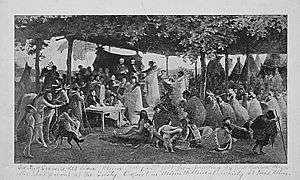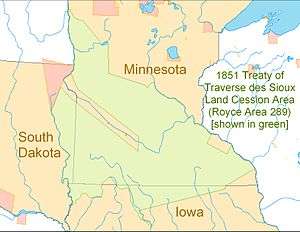Treaty of Traverse des Sioux
The Treaty of Traverse des Sioux (10 Stat. 949) was signed on July 23, 1851, at Traverse des Sioux in Minnesota Territory between the United States government and Sioux Indian bands in Minnesota Territory. By this treaty, the Sioux ceded large tracts of territory and agreed to move on to reservations along the Minnesota River in exchange for annuities of cash and goods.

by Frank Blackwell Mayer

The treaty was instigated by Alexander Ramsey, the first governor of Minnesota Territory, and Luke Lea, Commissioner of Indian Affairs in Washington, D.C. The United States wanted the treaty to gain control of agricultural lands for more European-American settlers.
Background
The Wahpeton and Sisseton bands of the Upper Dakota (sometimes spelled Dahkotah on treaties) were hesitant to sign away so much land, but older members of the tribes believed that the results of the 1825 First Treaty of Prairie du Chien and the Sioux defeat in the Black Hawk War limited their choices. The Wahpeton and Sisseton bands ceded their lands in southern and western Minnesota Territory, along with some lands in Iowa and Dakota Territory. In exchange, the United States promised payment of $1,665,000 in cash and annuities.
Through the Treaty of Traverse des Sioux and the Treaty of Mendota, the Mdewakanton and Wahpekute bands of the Lower Sioux ceded territory of nearly 24,000,000 acres (97,000 km2) of land. The US paid the Dakota an annuity the equivalent of 7.5 cents an acre and charged settlers $1.25 an acre.
The US set aside two reservations for the Sioux along the Minnesota River, each about 20 miles (30 km) wide and 70 miles (110 km) long. Later the government declared these were intended to be temporary, in an effort to force the Sioux out of Minnesota.
The Upper Sioux Agency was established near Granite Falls, Minnesota, while the Lower Sioux Agency was established about thirty miles downstream near what developed as Redwood Falls, Minnesota. The Upper Sioux were not satisfied with their reservation because of low food supplies, but as it included several of their old villages, they agreed to stay. The Lower Sioux were displaced from their traditional woodlands, and were dissatisfied with their new territory of mostly prairie.
The Sioux also resented the separate "trader's paper" that was included in the treaty, as it paid $400,000 of the promised treaty annuity total to fur traders and mixed-bloods who had financial claims against the tribes. Traders' papers were documents that contained the names of traders, included in the aforesaid claims, who were due fees from previous trades. It said that they were allowed to take in land currency what may have been owed them out of the Dakotas' treaty payments. The Dakota agreed to sign the treaty but also requested a copy. Upon signing the copy, they were asked to sign a third paper which they believed to be a third copy. The Dakota were tricked into signing these "trader's papers", as the interpreters had not accurately told them what the document meant.
Despite these issues, the crush of settlers moving into the area meant more European-American people encroaching on Sioux land. As the US had promised increased annuity payments in exchange for more land cessions, Sioux leaders went to Washington, D.C. in 1858 to sign another pair of treaties; these ceded the reservation north of the Minnesota River.
The US intended the treaties to encourage the Sioux to convert from their nomadic hunting lifestyle into more European-American settled farming, offering them compensation in the transition. The forced change in lifestyle and the much lower than expected payments from the federal government caused economic suffering and increased social tensions within the tribes. Tensions erupted in the Dakota War of 1862.
Terms
The preamble begins with,
Articles of a treaty made and concluded at Traverse des Sioux, upon the Minnesota River, in the Territory of Minnesota, on the twenty-third day of July, eighteen hundred and fifty-one, between the United States of America, by Luke Lea, Commissioner of Indian Affairs, and Alexander Ramsey, governor and ex officio superintendent of Indian affairs in said Territory, commissioners duly appointed for that purpose, and See-see-toan and Wah-pay-toan bands of Dakota or Sioux Indians ...
— Treaty with the Sioux-Sisseton and Wahpeton Bands, 1851
The abbreviated terms of the treaty were:
1. Peace and friendship shall be perpetual
2. Land to cede
3. Stricken out by U.S. Senate.
4. Payments and other payments held in trust.
5. Laws against liquors in Indian country.
6. Rules and regulations to protect the rights of persons and property among the Indians.
Signers included Sleepy Eye, of the Sisseton Sioux.[1]
See also
References
- "Ish Tak Ha Be (Sleepy Eye)". Minnesota State University Mankato. 2010-05-31. Archived from the original on May 31, 2010. Retrieved 2013-03-06.CS1 maint: unfit url (link)
- Carley, Kenneth (1976). The Sioux Uprising of 1862 (Second ed.). Minnesota Historical Society. ISBN 0-87351-103-4.
- Lass, William E. (1998) [1977]. Minnesota: A History (2nd ed.). New York, NY: W. W. Norton & Company. ISBN 0-393-04628-1.
External links
- Treaty with the Sioux—Sisseton and Wahpeton Bands, 1851. Treaty as ratified (i.e., with Section 3 stricken). Archived copy of University of Oklahoma reproduction of relevant pages of Indian Affairs: Laws and Treaties, Volume II, Charles J. Kappler (ed.). Washington: Government Printing Office, 1904.
- The treaty of Traverse des Sioux in 1851 : under Governor Alexander Ramsey, with notes of the former treaty there, in 1841, under Governor James D. Doty, of Wisconsin. Library of Congress. Contemporary description of background and signing of treaty.